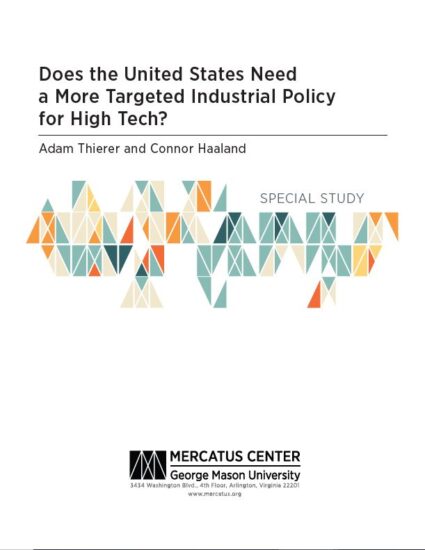This is a compendium of readings on “progress studies,” or essays and books which generally make the case for technological innovation, dynamism, economic growth, and abundance. I will update this list as additional material of relevance is brought to my attention.
[Last update: 10/11/22]
Recent Essays
- Marc Andreessen, “The Techno-Optimist Manifesto,” a16z.com, October 16, 2023.
- Will Rinehart, “The Abundance Agenda,” The Exformation Newsletter, October 15, 2022.
- Sarah Constantin, “Unblocking Abundance: A Model for Activism,” Rough Diamonds, October 10, 2022.
- Derek Thompson, “The Forgotten Stage of Human Progress,” The Atlantic, May 11, 2022.
- Adam Thierer, “Where is ‘Progress Studies’ Going?” Progress Forum, April 23, 2022.
- Katherine Boyle, “The Case for American Seriousness,” Common Sense, April 18, 2022.
- William Rinehart, “Vetocracy, the Costs of Vetos and Inaction,” Center for Growth & Opportunity at Utah State University, March 24, 2022.
- James Pethokoukis, “Forget about Left Wing and Right Wing. How about an Up Wing America?” Faster Please, March 23, 2022.
- John W. Lettieri & Kenan Fikri, “The Case for Economic Dynamism and Why it Matters for the American Worker,” Economic Innovation Group, March 2022.
- Adam Kovacevich, “Saying YIMBY (Yes In My Back Yard) to “Civic Innovation,” Chamber of Progress, March 21, 2022.
- Eli Dourado, “Remove Barriers to Productivity,” City Journal, March 18, 2022.
- “A Case for Innovation and Optimism,” (A conversation with Jason Crawford), Discourse, March 2, 2022.
- Noah Smith, “A New Industrialist Roundup,” Noahpinion, February 3, 2022.
- James Pethokoukis, “When Will the Next Big Thing Arrive?” Faster Please, February 3, 2022.
- Alec Stapp & Caleb Watney, “Progress is a Policy Choice,” Institute for Progress, January 20, 2022.
- Adam Thierer, “How to Get the Future We Were Promised,” Discourse, January 18, 2022.
- Katherine Boyle, “Building American Dynamism,” Future, January 14, 2022.
- Derek Thompson, “A Simple Plan to Solve All of America’s Problems,” The Atlantic, January 12, 2022.
- Jason Crawford, “Progress, Humanism, Agency: An Intellectual Core for the Progress Movement,” Roots of Progress, January 11, 2022.
- Adam Thierer, “Defending Innovation Against Attacks from All Sides,” Discourse, November 9, 2021.
- Matthew Yglesias, “The Case for More Energy,” October 7, 2021.
- Jason Crawford, “We need a new philosophy of progress,” The Roots of Progress, August 23, 2021.
- Gale Pooley & Marian L. Tupy, “The Simon Abundance Index 2021,” Human Progress, April 22, 2021.
- Noah Smith, “Techno-optimism for the 2020s,” December 3, 2020.
- Ezra Klein, “Why We Can’t Build,” Vox, April 22, 2020.
- Marc Andreesen, “It’s Time to Build,” Future, April 18, 2020.
- Eli Dourado, “How do we move the needle on progress?” September 26, 2019.
- José Luis Ricón, “About the ‘Progress’ in Progress Studies” September 6, 2019.
- Will Rinehart, “Progress Studies: Some Initial Thoughts,” August 30, 2019.
- Adam Thierer, “Is There a Science of Progress?” AIER, August 8, 2019.
- Patrick Collison and Tyler Cowen, “We Need a New Science of Progress,” The Atlantic, July 30, 2019.
- Tyler Cowen, “The Case for the Longer Term,” Cato Unbound, January 9, 2019.
- Vinod Khosla, “We Need Large Innovations,” Medium, January 1, 2018.
- Adam Thierer, “How Technology Expands the Horizons of Our Humanity,” Medium, November 19, 2018.
- Chelsea Follett, “Utopianism: One of the Biggest Obstacles to Progress,” Human Progress, August15, 2018.
- Eli Dourado, “How Technological Innovation Can Massively Reduce the Cost of Living,” PlainText, January 29, 2016.

 Discourse magazine has just published
Discourse magazine has just published 


 In my latest column for The Hill, I consider that dangers of government gambling our tax dollars on risky industrial policy programs. I begin by noting:
In my latest column for The Hill, I consider that dangers of government gambling our tax dollars on risky industrial policy programs. I begin by noting: The Technology Liberation Front is the tech policy blog dedicated to keeping politicians' hands off the 'net and everything else related to technology.
The Technology Liberation Front is the tech policy blog dedicated to keeping politicians' hands off the 'net and everything else related to technology.